Fuel metabolism in Canada geese: effects of glucagon on glucose kinetics
- PMID: 26108869
- PMCID: PMC4591372
- DOI: 10.1152/ajpregu.00080.2015
Fuel metabolism in Canada geese: effects of glucagon on glucose kinetics
Abstract
During prolonged fasting, birds must rely on glucose mobilization to maintain normoglycemia. Glucagon is known to modulate avian energy metabolism during prolonged fasting, but the metabolic effects of this hormone on long-distance migrant birds have never been investigated. Our goal was to determine whether glucagon regulates the mobilization of the main lipid and carbohydrate fuels in migrant birds. Using the Canada goose (Branta canadensis) as a model species, we looked for evidence of fuel mobilization via changes in metabolite concentrations. No changes could be found for any lipid fraction, but glucagon elicited a strong increase in glucose concentration. Therefore, we aimed to quantify the effects of this hormone on glucose kinetics using continuous infusion of 6-[(3)H]-d-glucose. Glucagon was found to cause a 50% increase in glucose mobilization (from 22.2 ± 2.4 μmol·kg(-1)·min(-1) to 33.5 ± 3.3 μmol·kg(-1)·min(-1)) and, together with an unchanged rate of carbohydrate oxidation, led to a 90% increase in plasma glucose concentration. This hormone also led to a twofold increase in plasma lactate concentration. No changes in plasma lipid concentration or composition were observed. This study is the first to demonstrate how glucagon modulates glucose kinetics in a long-distance migrant bird and to quantify its rates of glucose mobilization.
Keywords: Branta canadensis; hepatic glucose production; in vivo tracer infusion; indirect calorimetry; metabolic substrates.
Copyright © 2015 the American Physiological Society.
Figures
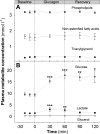
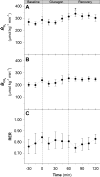
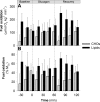
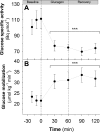
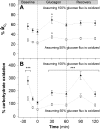
References
-
- Abdul-Malak N, Brichon G, Meister R, Zwingelstein G. Environmental temperature and metabolism of molecular species of phosphatidylcholine in the tissues of the rainbow trout. Lipids 24: 318–324, 1989.
-
- Babin PJ, Vernier JM. Plasma lipoproteins in fish. J Lipid Res 30: 467–489, 1989. - PubMed
-
- Bergmeyer HU. Methods of Enzymatic Analysis. New York: Academic Press, 1974.
-
- Bernard SF, Thil MA, Groscolas R. Lipolytic and metabolic response to glucagon in fasting king penguins: phase II vs. phase III. Am J Physiol Regul Integr Comp Physiol 284: R444–R454, 2003. - PubMed
Publication types
MeSH terms
Substances
LinkOut - more resources
Full Text Sources
Other Literature Sources
Medical
Miscellaneous

